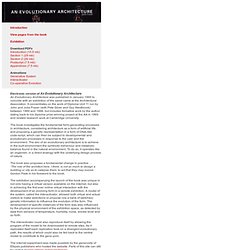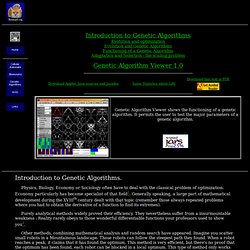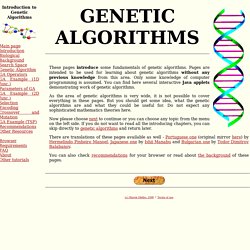

References about Galapagos? An Evolutionary Architecture - John Frazer. Electronic version of An Evolutionary Architecture An Evolutionary Architecture was published in January 1995 to coincide with an exhibition of the same name at the Architectural Association.

It concentrates on the work of Diploma Unit 11 run by John and Julia Frazer (with Pete Silver and Guy Westbrook) between 1989 and 1996, but includes formative work by the author dating back to his diploma prize-winning project at the AA in 1969 and related research work at Cambridge University. The book investigates the fundamental form-generating processes in architecture, considering architecture as a form of artificial life, and proposing a genetic representation in a form of DNA-like code-script, which can then be subject to developmental and evolutionary processes in response to the user and the environment. The aim of an evolutionary architecture is to achieve in the built environment the symbiotic behaviour and metabolic balance found in the natural environment.
Introduction to Genetic Algorithm. Introduction to Genetic Algorithms.

Physics, Biology, Economy or Sociology often have to deal with the classical problem of optimization. Economy particularly has become specialist of that field1. Generally speaking, a large part of mathematical development during the XVIIIth century dealt with that topic (remember those always repeated problems where you had to obtain the derivative of a function to find its extremes). Purely analytical methods widely proved their efficiency. They nevertheless suffer from a insurmountable weakness : Reality rarely obeys to those wonderful differentiable functions your professors used to show you2. Other methods, combining mathematical analysis and random search have appeared. What could be the link between optimization methods and artificial life ?
A- Evolution and optimization. We are now 45 millions years ago examining a Basilosaurus : Basilosaurus The Basilosaurus was quite a prototype of a whale. Genetic Algorithms. Genetic Algorithm Tutorial. Genetic Algorithms in Plain English Introduction The aim of this tutorial is to explain genetic algorithms sufficiently for you to be able to use them in your own projects.

This is a stripped-down to-the-bare-essentials type of tutorial. I'm not going to go into a great deal of depth and I'm not going to scare those of you with math anxiety by throwing evil equations at you every few sentences. In fact, I'm not going to throw any nasty equations at you at all! This tutorial is designed to be read through twice... so don't worry if little of it makes sense the first time you study it. (A reader, Daniel, has kindly translated this tutorial into German.
(Another reader, David Lewin, has translated the tutorial into French. First, a Biology Lesson Every organism has a set of rules, a blueprint so to speak, describing how that organism is built up from the tiny building blocks of life. When two organisms mate they share their genes. Now let's zip a few thousand generations into the future. Main page - Introduction to Genetic Algorithms - Tutorial with Interactive Java Applets. These pages introduce some fundamentals of genetic algorithms.

Pages are intended to be used for learning about genetic algorithms without any previous knowledge from this area. Only some knowledge of computer programming is assumed. You can find here several interactive Java applets demonstrating work of genetic algorithms. As the area of genetic algorithms is very wide, it is not possible to cover everything in these pages. But you should get some idea, what the genetic algorithms are and what they could be useful for.
Now please choose next to continue or you can choose any topic from the menu on the left side. There are translations of these pages available as well - Portuguese one (original mirror here) by Hermelindo Pinheiro Manoel, Japanese one by Ishii Manabu and Bulgarian one by Todor Dimitrov Balabanov. You can also check recommendations for your browser or read about the background of these pages. (c) Marek Obitko, 1998 - Terms of use.